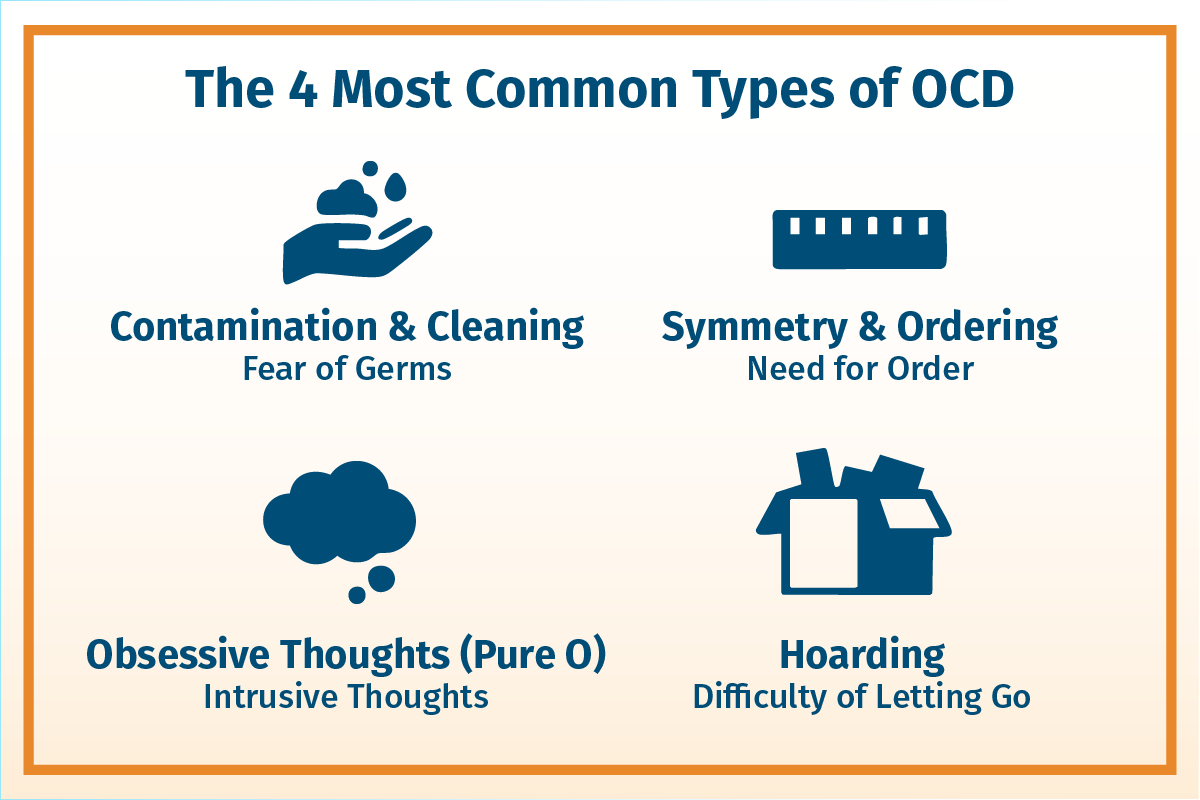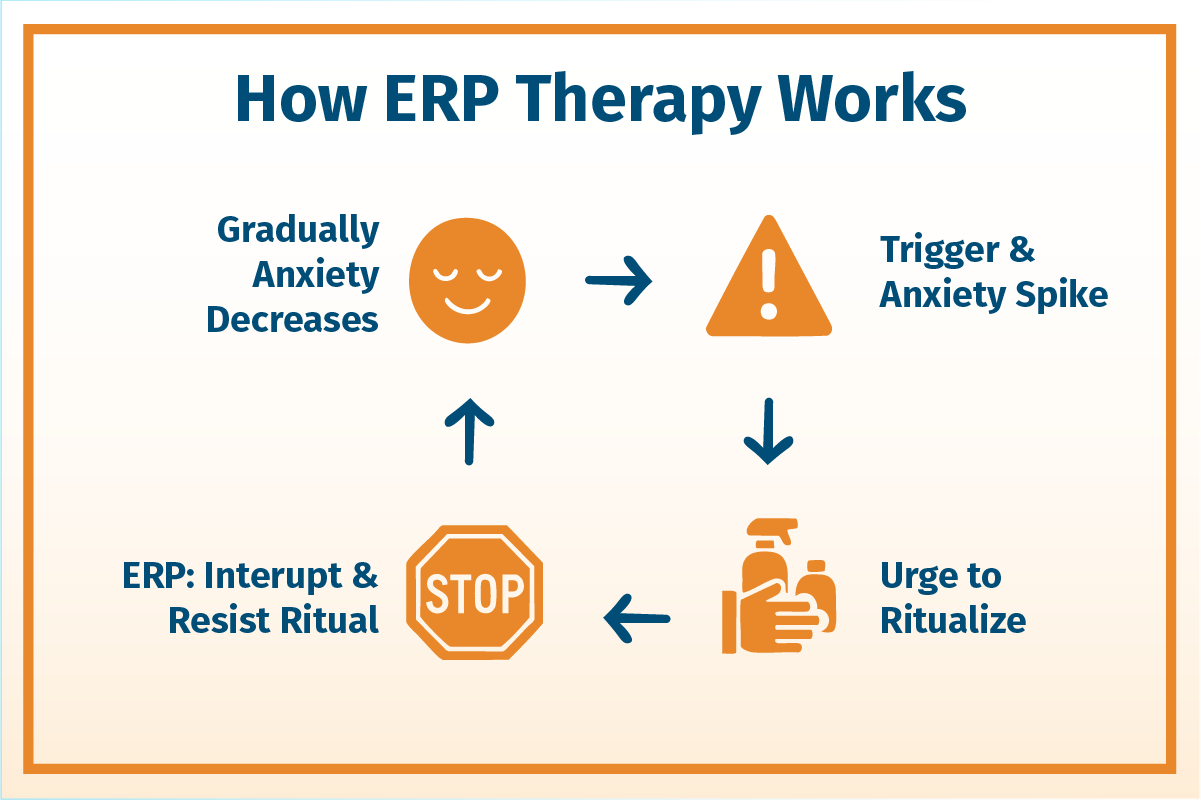What Are The 4 Types of OCD?
Call us today to get the support and guidance you deserve.
Obsessive-Compulsive Disorder (OCD) isn’t about being tidy or particular. It’s a mental health condition that can take over your thoughts and routines in ways that feel hard to control.
Understanding what OCD is and how it’s misunderstood can help you or your loved one recognize symptoms and seek support sooner.
What Is Obsessive-Compulsive Disorder?
OCD is a condition where a person experiences recurring, distressing thoughts (obsessions) and feels compelled to repeat certain actions or routines (compulsions) to ease the anxiety.
These patterns can disrupt daily life, including school, work, relationships, and self-esteem.
Even when someone knows their thoughts don’t make sense, they can feel impossible to stop. Compulsions are meant to relieve the fear—but they often make it worse over time.
Common Misconceptions About OCD?
Many think OCD is just about being extra clean or organized. You might hear someone say they’re “so OCD,” but OCD is far more serious than a personality quirk.
Other common myths include:
- “People with OCD just need to relax.” OCD isn’t about stress—it’s a clinical disorder that needs treatment.
- “You can always tell when someone has OCD.” Many people show no visible signs.
- “It’s rare.” OCD affects millions, including teens and children.
- “If they’re not doing rituals, it’s not OCD.” Many compulsions happen mentally, like repeating phrases or avoiding certain thoughts.
When OCD is misunderstood, people who have it often hide their symptoms or delay treatment—making things worse.
The 4 Common Types of OCD
OCD shows up in different ways, depending on the person’s thoughts and coping behaviors. Most experience one or more of these types:

Contamination and Cleaning
Contamination OCD is one of the most common forms of OCD 🛈. It involves an intense fear of germs, illness, or being exposed to something that feels unsafe or unclean.
This type of OCD can become so disruptive that it interferes with daily routines, damages relationships, and makes ordinary environments feel unsafe.
A person with this type might have thoughts like:
“What if I get sick or get someone else sick?”
“That’s dirty. I touched it. Now everything’s contaminated.”
“What if this food isn’t safe?”
“I didn’t clean that right—something bad is going to happen.”
To try to quiet those fears, they might:
Wash their hands repeatedly, sometimes for a set amount of time or in a certain order
Avoid touching door handles, public surfaces, or using shared bathrooms
Refuse to eat food prepared by others or worry constantly about food safety
Clean or disinfect objects multiple times, even when they don’t look dirty
Ask others for reassurance that they’re clean or haven’t been exposed to something dangerous
Symmetry and Ordering
This type of OCD involves a strong need for things to feel balanced, even, or “just right.”
Some people worry that something bad could happen if things aren’t done a certain way. Others don’t have a specific fear—they just feel a deep sense of tension or unease until things are “correct.”
A person with this type of OCD might have thoughts like:
“That’s uneven—fix it or something bad will happen.”
“If I don’t tap it the right number of times, the feeling won’t go away.”
“That didn’t feel right. Do it again.”
“The left side doesn’t match the right—something’s off.”
To try to calm the discomfort or fear, they might:
Arrange items until they’re perfectly lined up
Tap or touch objects a specific number of times
Repeat certain movements or steps in a routine
Avoid moving on from a task until it “feels right”
These rituals can take up large parts of the day, making it hard to finish basic tasks like getting dressed, doing homework, or leaving the house.
Obsessive Thoughts (“Pure O”)
This type of OCD centers around unwanted thoughts that feel disturbing, wrong, or out of character. These thoughts can focus on violence, sex, religion, or other topics that are considered taboo.
Even though the person has no desire to act on them, the thoughts keep showing up—and can be hard to control or explain. Many people with this type of OCD feel ashamed or isolated, which can delay getting help.
A person with this type of OCD might have thoughts like:
“What if I hurt someone without meaning to?”
“Does having that thought mean I’m a bad person?”
“What if I said something offensive and didn’t realize it?”
“Why can’t I stop thinking about that image?”
Instead of physical compulsions, they might:
Silently repeat words or phrases to “cancel out” a thought
Avoid certain people, places, or situations
Recheck memories or conversations in their head
Ask for reassurance, again and again, to feel certain they’re not dangerous or immoral
Because this form of OCD involves mental rituals, it can be harder to spot—but it’s just as disruptive.
These thoughts can take over someone’s focus, making it hard to concentrate in class, enjoy relationships, or feel safe in their own mind.
Hoarding
Hoarding OCD involves a strong need to keep things, even objects that seem broken, used up, or unnecessary. Getting rid of them can feel unsafe, wrong, or like it could lead to something bad happening.
These habits can take over living spaces and strain relationships with family and roommates. Some people feel too embarrassed to invite others into their homes.
A person with this type might have thoughts like:
“What if I need this someday?”
“If I throw this away, I’ll regret it.”
“Getting rid of this could cause something bad to happen.”
“This has meaning. I can’t let it go.”
To ease the anxiety, they might:
Hold on to old papers, packaging, or items “just in case”
Avoid cleaning or organizing for fear of discarding something important
Spend hours trying to decide what to keep and what to throw away
Keep objects in specific places or piles that feel too stressful to disturb

How Is OCD Treated?
OCD is highly treatable, even for people who’ve struggled with it for years.
The most effective approach is Cognitive Behavioral Therapy (CBT), especially a method called Exposure and Response Prevention (ERP) 🛈:
CBT helps identify patterns between thoughts, feelings, and behaviors.
ERP involves gradually facing triggers while resisting compulsions, reducing fear over time.
Research shows ERP can significantly improve quality of life for people with OCD. 🛈
Other helpful tools include:
Medication (often SSRI, a type of antidepressant)
Support groups or peer communities
Mindfulness and distress tolerance skills
OCD may not go away completely, but with proper treatment, it can become something you can understand and manage, not something that controls your life.
Taking the First Step Toward OCD Recovery
At The Recovery Team, we provide specialized care for OCD and other mental health conditions. Our services include outpatient therapy, residential programs, and a fully staffed inpatient psychiatric unit for those who need more intensive support.
We offer therapy tailored to OCD, along with a wide range of other treatment options—including dual diagnosis support for those also dealing with substance use disorder, medication management, and help for related issues like anxiety and depression. Our licensed team builds personalized plans that meet you where you are.
If you’re ready to take the next step, we’re here to help.
